- Established 1982 -HOME: www.hiltonpond.org
THIS WEEK at HILTON POND Subscribe for free to our award-winning nature newsletter (Back to Preceding Week; on to Next Week) |
BLUE HEADED OR SOLITARY? Except during rain events, most days this fall we've deployed mist nets for bird banding at Hilton Pond Center. Summer birds are mostly gone by mid-October but during the latter half of the month we saw lots of other migrant birds that may spend the winter with us--including an unusually big influx of Yellow-rumped Warblers. Mixed in with these on 31 October 2021 was a bird we've seldom seen and banded few times locally: A Blue-headed Vireo (BHVI, see photos below), only our 19th in 40 years here.
All text, maps, charts & photos © Hilton Pond Center BHVI used to be SOVI, the alpha code for Solitary Vireo--a common name whose origins seem mysterious but that gave rise to the scientific epithet: Vireo solitarius. (Taxonomic Note: Historically, the three similar-looking vireos--Plumbeous, Cassin's, and Blue-headed--were lumped in the 1950s as one called "Solitary Vireo." Further DNA and behavioral studies led ornithologists to admit the error of their ways and in 1997 the three were split out again as different species that did not breed with each other.) The vireo we captured is correctly known these days by its more descriptive common name, primarily because it has a blue head contrasting with an olive back. Additional prominent Blue-headed Vireo field marks include a huge white eye ring, double white wing bars, and yellowish flanks. The black, heavy vireo bill with a small hook at its tip is another identifying characteristic. Sexes look alike.
All text, maps, charts & photos © Hilton Pond Center Our other eastern U.S. vireos--Philadelphia, Red-eyed, and White-eyed (WEVI)--are not cold-weather enthusiasts. They typically bail out of the Piedmont and fly south to much warmer climes in autumn, although some Blue-headed Vireos (and a few White-eyeds) spend the winter in South Carolina's Coastal plain. (BHVI and WEVI are occasionally seen on Christmas Bird Counts in the Piedmont Region; we've had Blue-headed on the York-Rock Hill SC survey in four different Decembers, but never a White-eyed.) Oddly enough, one researcher found that during migration Blue-headed Vireos tend to hang out with various sparrows rather than vireos or other tree-dwelling songbirds. Blue-headed Vireos build a hanging cup-shaped nest at sites up the Southern Appalachians into New England and much of Canada, breeding primarily in cool, temperate, mixed forests. There they are insectivores, and that powerful hook-tipped bill can make short work of a juicy caterpillar. Come winter BHVI are by necessity more frugivorous, dining primarily on wild fruits and berries but ever on the lookout for an active bug or two. Although it seems possible Blue-headed Vireos would visit suet feeders in winter, we've heard no reports of such behavior. (Please let us know if you do by e-mailing INFO.) All text, maps, charts & photos © Hilton Pond Center Another migratory species rarely captured at Hilton Pond Center showed up in our nets on 4 and 12 October: Black-throated Green Warbler (BTNW). We first banded this species in 1987 and never had more than five in a season; most years we get none but now have a grand total of 26 banded.
All text, maps, charts & photos © Hilton Pond Center BTNW are smallish parulids (see bander's hand for scale in the photo above), half-an-inch shorter than the hulking 4-3/4" Yellow-rumped Warbler. Breeding males have a solid black throat and a distinctive golden face; adult females are similar but with streaked flanks and a much duller throat. The bird in our photos is a young male. All ages and sexes have dual white wingbars white tail spots, and olive-greenish backs with light streaking.
All text, maps, charts & photos © Hilton Pond Center Black-throated Green Warblers breed from the southern Appalachians into New England and across much of southern Canada; up north they nest primarily in coniferous forests while utilizing hardwood stands further south. Interestingly, there is a disjunct population ("Wayne's subspecies") that breeds within Baldcypress swamps in coastal North Carolina and Virginia. BTNW forage for insects in the canopy when in North America and frequent similar habitat after migrating to coastal Mexico, Central America, and northwestern South America. Only once have we caught a Black-throated Green Warbler in spring migration. We suspect this is because they come north through eastern Mexico and pass west of the Carolina Piedmont on their way to breeding areas. All text, maps, charts & photos © Hilton Pond Center Although we do get southbound migrants during October, some birds we band during the month at Hilton Pond Center are not true migrants. Instead, they illustrate a phenomenon known as the "fall shuffle," during which they disperse from their natal grounds to places a relatively short distance away. This behavior enables young-of-the-year to colonize new areas and also may minimize inbreeding with parents or siblings. Based on 40 years of banding at the Center, we've observed apparent "fall shuffling" in several non-migrants--especially Northern Cardinals and Carolina Chickadees. Most years we band good numbers of these two species in early and mid-summer soon after they fledge from local nests. Then there's a September lull before we encounter a sudden increase of unbanded individuals--almost all hatch-year individuals--during October and early November. All text, maps, charts & photos © Hilton Pond Center One bird that used to be part of our fall shuffle is Eastern Towhee (EATO), a species abundant around Hilton Pond through the mid-1990s (see chart above). Numbers dropped after that, partly because our 11 acres transitioned into young woodland from shrubby habitats towhees prefer. We also suspect an outbreak of West Nile Virus caused significant die-off among EATO that are a common target for disease-carrying mosquitoes. And making matters even worse, Brown-headed Cowbirds have taken a toll, with towhees apparently a favorite host for these nest parasites.
All text, maps, charts & photos © Hilton Pond Center Among birdwatchers, Eastern (formerly Rufous-sided) Towhees are a favorite, with the black and white rust colors of the adult male (above) contrasting with the female's equally eye-pleasing brown and white and rust. (Our photo below shows a young female we banded this week; she hasn't quite acquired the deep rich brown plumage of a mature adult.) 'Round these parts, immature birds have pale muddy-orange irises that change to crystal-clear red in adults, although some coastal and more southerly populations have light yellow or white eyes.
All text, maps, charts & photos © Hilton Pond Center Towhees have large feet they use to scratch through leaf litter as they search for invertebrates, seeds, and fruits. Their substantial mandibles make short work of any beetles and bugs they come across. Their "drink-your-tea" mating song is easily recognizable, as is the year-round "chewink" call through which mated pairs and parents and offspring stay in constant touch. We should point out that northern populations of Eastern Towhees--which breed across the eastern half of the U.S.--do exhibit short-distance migration, so some EATO that suddenly appear at Hilton Pond Center in October could be either migrants or fall shufflers. Towhees that breed in the high Appalachians of North Carolina move to lower elevations in winter. (NOTE: None of the 755 towhees banded locally have been encountered elsewhere, nor have we captured any banded by someone else.) BIRD ANOMALIES Although birds are fascinating to look at and--for licensed bird banders--delightful to hold, sometimes we encounter individuals with defects or disease. This week, for example, we caught an immature female Cape May Warbler (below) with a malformity in which the tip of the upper bill crossed over a normally shaped lower mandible.
All text, maps, charts & photos © Hilton Pond Center It's hard to know what caused this unusual growth. The base of the upper bill is also oddly shaped, so perhaps an injury when the bird was young caused the rest of the bill to grow abnormally. The U.S. Geological Survey has studied bill deformities--called "avian keratin disorder (AKD)"--and concludes they are likely caused by "a variety of factors, including contaminants, nutritional deficiencies, disease, parasites, blunt trauma, or genetic abnormalities." In the case of AKD in Alaskan populations of Black-capped Chickadees, government researchers narrowed probable suspects to: 1) a novel picornavirus (Poecivirus) that may be contagious, and/or, 2) DNA damage likely caused by environmental contaminants or a disease pathogen. In some cases bill deformities are relatively benign, but it's hard to imagine the Cape May Warbler in our photo being able to grab and consume tiny insects that comprise the bulk of its diet. Nonetheless, she put on enough fat to make it to Hilton Pond from the species' breeding grounds in Canada, so in the short run she seems to have adapted to her handicap.
All text, maps, charts & photos © Hilton Pond Center The second anomaly was an adult female Yellow-rumped Warbler with a bad case of "scaly-leg" on all her toes and both legs. This affliction--technically called knemidocoptiasis--is caused by a mite (Knemidokoptes spp.) that burrows into spaces between scales on a bird's walking appendages. This results in dermatitis and lesions that can grow to such size they interfere with locomotion, foraging, and mating. The mites--common in cage birds--can also cause scaling at the base of the bill. Mites are transmitted bird to bird, especially from parents to young in the nest. Incidentally, we released the warbler in our photo without applying a band that would rub against the tender lesions and cause bleeding. All text, maps, charts & photos © Hilton Pond Center A HALLOWEEN WARNING Although it may be too late for Halloween 2021, here's something to think about for 2022 and thereafter: Y'know those artificial spider webs that are in vogue as a Halloween decoration? Not only are they a waste of money and natural resources, they're also a potential death trap for birds (and other small animals--including lizards and bats). The photo below (not ours) depicts a now-dead female Downy Woodpecker whose tongue, feet, and tail are ensnared in a fake web. If you have any of this junk stored away, destroy it immediately and pass this info on to other folks.
All text, maps, charts & photos © Hilton Pond Center We might mention that discarded fishing line and plastic mesh used to protect fruit trees from birds both play havoc with wildlife that get caught up in the plastic. Do what you can to help nature avoid such needless catastrophes. All text, maps, charts & photos © Hilton Pond Center AND THE GRANDDAUGHTERS AS FIELD ASSISTANTS
All text, maps, charts & photos © Hilton Pond Center In happier news, on 17 October 2021 granddaughters McKinley Ballard Hilton and Hadley Reid Hilton were helping Pap Hilton band birds at Hilton Pond Center and caught this hatch-year Blue Jay. You'll never guess what their mascot is at Oakwood Elementary School in Hickory, North Carolina! All text, maps, charts & photos © Hilton Pond Center Don't forget to scroll down for lists of all birds banded and recaptured during the week. HILTON POND SUNSETS "Never trust a person too lazy to get up for sunrise
All text, maps, charts & photos © Hilton Pond Center Sunset over Hilton Pond (above), 16 October 2021
All text, maps, charts & photos © Hilton Pond Center Sunset over Hilton Pond (above), 31 October 2021 Photoshop image post-processing for this page employs |
|---|
|
"This Week at Hilton Pond" is written and photographed by Dr. Bill Hilton Jr., executive director of Hilton Pond Center for Piedmont Natural History
|
|
|
Please refer "This Week at Hilton Pond" to others by clicking on this button: |
|

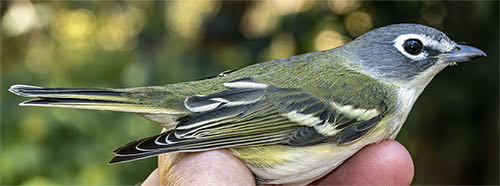

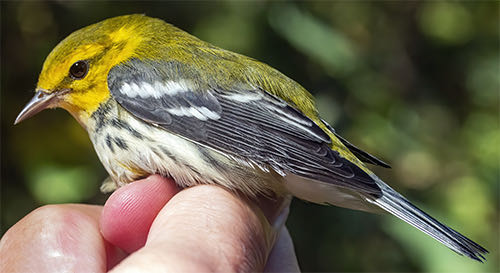
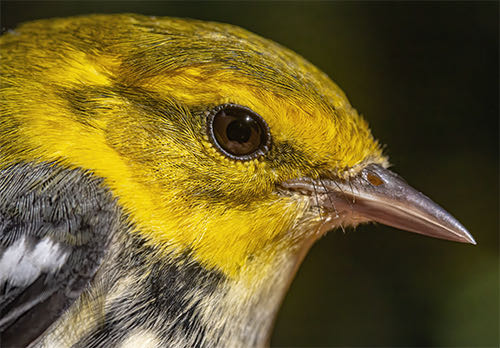
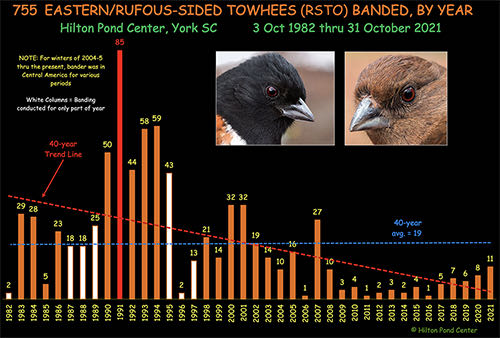
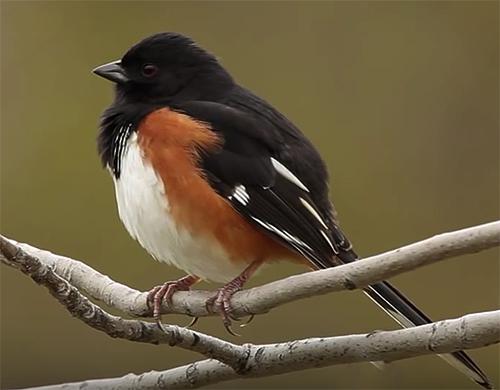
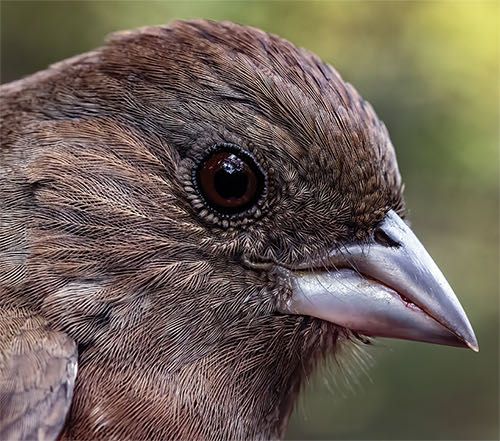
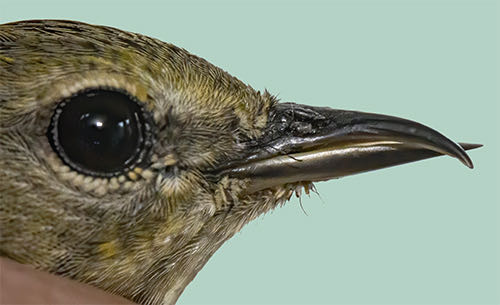

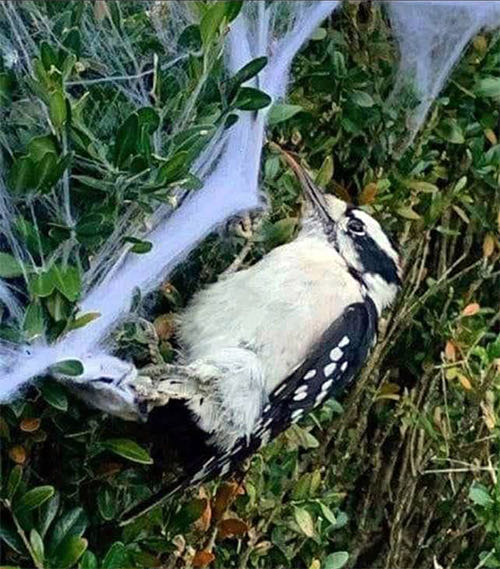
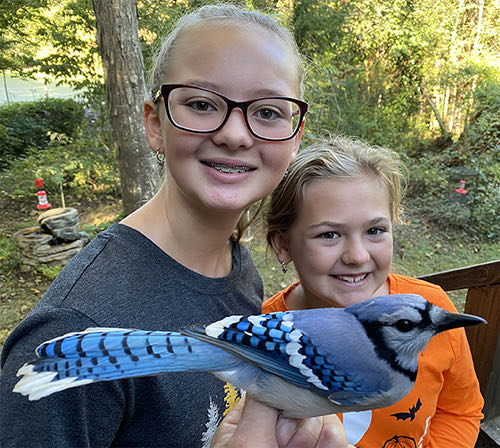
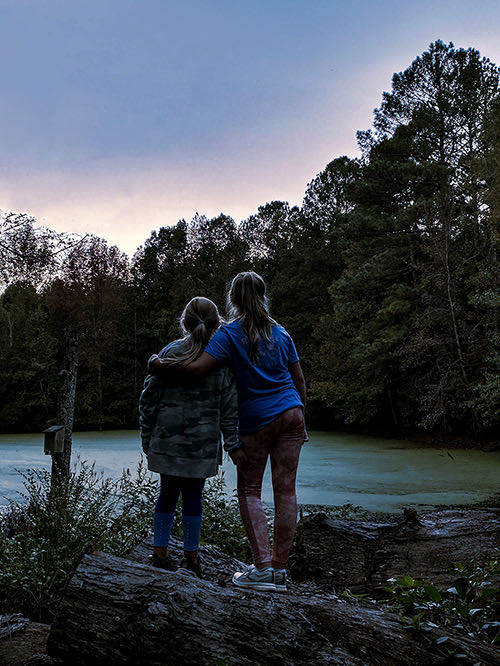










 Please report your spring, summer &
Please report your spring, summer & Oct 15 to Mar 15:
Oct 15 to Mar 15: